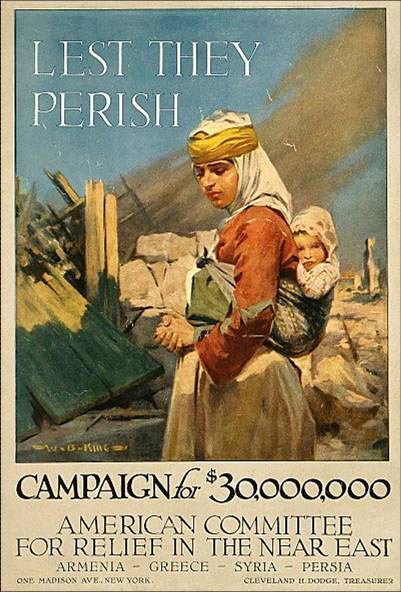100 Years Ago Today
The committee that would become Near East Relief met for the first time on September 16, 1915. One hundred years later, the Near East Foundation continues NER’s legacy of helping vulnerable populations through sustainable development programs.

When Ambassador Henry Morgenthau, Sr. received word of the deportations of Armenians from the Turkish interior, he exhausted diplomatic channels. He met with Ottoman officials, but made no progress. On Sept. 3, 1915, Morgenthau sent a telegram to the U.S. State Department requesting that the Secretary of State ask several prominent American men to form a committee to raise funds for Armenian refugees. This telegram launched the committee that would become Near East Relief.
Noted industrialist and philanthropist Cleveland H. Dodge called the first meeting at his office in Manhattan on Sept. 16, 1915. Dr. James L. Barton brought years of experience as Foreign Secretary of the American Board of Commissioners of Foreign Missions in Boston, MA. Other attendees included Rabbi Stephen Wise, a progressive voice in the Reform Judaism movement and founder of the Free Synagogue, and Dr. Samuel T. Dutton, a former school superintendent and Columbia University professor.

The Board upon Ambassador Morgenthau's return to the U.S., 1916. Morgenthau is seated at left.
Believing their task to be temporary, the men committed $60,000 from their own resources at this first meeting. The men prevailed upon their acquaintances and business associates for additional funds. They wired $100,000 to Morgenthau in Constantinople in October 1915.
The founders called the group the Armenian Relief Committee to reflect their special area of focus. Religious groups had already founded the Persian War Relief Fund and the Syria-Palestine Committee to raise funds for persecuted Christians in those regions. The committees chose to combine their efforts and resources in order to aid more people. The new group briefly adopted the name Armenian and Syrian Relief Committee before settling on the American Committee for Armenian and Syrian Relief (ACASR).

Former Ambassador Morgenthau, Dr. Samuel Dutton, and Cleveland H. Dodge in conversation
Ambassador Morgenthau returned to the U.S. in February 1916. He provided the Committee with a detailed report on conditions in the Near East based on observations and communications with missionaries in the Turkish interior. Morgenthau estimated that one million Armenians had survived the massacres of 1915. The survivors were mainly women and children, and they were all destitute. Hundreds of people in Constantinople were dying of starvation, having nothing to eat but grass. Morgenthau estimated that $5,000,000 was needed to relieve the suffering of minorities in Turkey, Syria, and Palestine. ACASR voted to make a public appeal for this amount. The members agreed to appeal to trusted friends in the press to share eyewitness accounts that had been smuggled from the Near East. By the end of 1916 ACASR was assisting as many as 500,000 women and children.
In Syria, where the local populations were suffering under famine conditions, the arrival of large numbers of Armenian refugees taxed local capacities even further, necessitating relief for refugees and local people alike. Across Turkey, the deportations had left the once-thriving mission stations in Armenian communities empty. Missionaries used Committee funds to convert existing mission buildings into relief centers and orphanages. The relief stations quickly filled with children – many of them the sons and daughters of former students. Harput and Constantinople became major orphanage centers in Turkey. Children in the Caucasus region found shelter in Kars, Erivan (now Yerevan, Armenia), and later Alexandropol (now Gyumri, Armenia).
Map of ACASR donations from 1915 - 1918. Courtesy of the Burke Library, Columbia University.

In late 1918 ACASR changed its name to the American Committee for Relief in the Near East (ACORNE). As World War I drew to a close, ACORNE turned its attention to the thousands of refugee children scattered across the former Ottoman territories. The organization raised an unprecedented $30 million for direct relief. By 1919 ACORNE had outgrown the resources of a volunteer committee. The organization was chartered by Congress and incorporated as Near East Relief in August 1919. By 1930, Near East Relief had saved more than one million lives. The organization had raised and educated more than 132,000 children in its vast system of orphanage schools.
One hundred years later, the Near East Foundation continues Near East Relief’s legacy. NEF has worked to improve health and livelihood in nearly 50 countries since 1915. Our work has impacted countless lives. Yet, as we embark upon our second century, the world is once again engulfed in a devastating refugee crisis. Let the memory of that first meeting on Sept. 16, 1915 be a renewed call to action for us all.
All proceeds from the Centennial Gala will go toward our Centennial Initiative to create economic resilience and positive coping mechanisms for Syrian Refugees and their host communities in Lebanon and Jordan.
